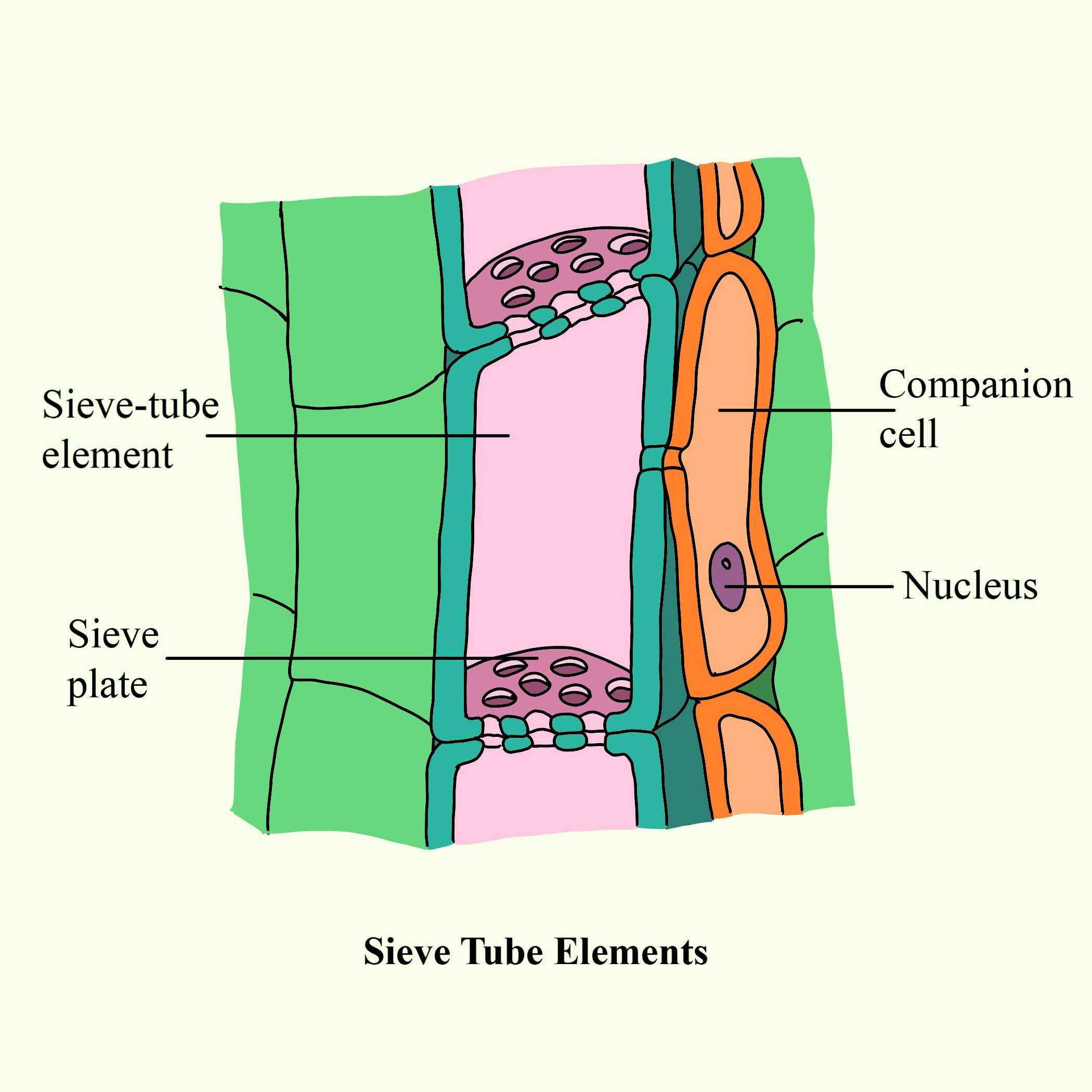
Which is wrong about sieve tube elements
(a)Peripheral cytoplasm and large vacuole
(b)Perforated end wall becomes impregnated with lignin
(c)P- protein occurs evenly and is distributed throughout the lumen
(d)Absence of nucleus at maturity
(e)Tube-like structures present in longitudinal series
Answer
476.4k+ views
Hint: Found in the phloem, sieve tube elements are very specialized cells due to their modified and metabolically restricted protoplasm. Phloem is also connected with contiguous sieve elements through modified cell wall areas.
Complete answer:
The phloem is the vascular tissue that is responsible for the translocation of photosynthate materials throughout a plant. It mainly comprises sieve elements, companion cells, phloem sclerenchyma, and phloem parenchyma cells.
The sieve tube elements are generally the main conductive cell in the phloem. It is a living cell with a protoplast. The nucleus is absent at maturity. There are also fewer organelles present. It is known to be a special type of sclerenchyma cell. However, the cell wall is not lignified. In angiosperms, the sieve element is termed as a sieve tube (element) and the cell associated with it is called a companion cell.
Additional Information: Sieve element cell is usually closely related to a ‘companion cell’ in angiosperms and an albuminous cell or ‘Strasburger cell’ in gymnosperms.
Companion cells that have a nucleus, are packed with dense cytoplasm and contain many ribosomes and mitochondria. That's why the companion cells are able to undertake the metabolic reactions and other cellular functions, which the sieve element cannot perform as it lacks the appropriate organelles. The sieve elements are therefore dependent upon the companion cells for their proper functioning and as well as survival.
So, the correct answer is 'Perforated end wall becomes impregnated with lignin’.
Note: Only the sieve tube and the companion cell have an ontogenetic relationship, that means they arise from a common mother cell. Additionally, the sieve element is connected to the specialized cell (companion cell or albuminous cell) through plasmodesmata.

Complete answer:
The phloem is the vascular tissue that is responsible for the translocation of photosynthate materials throughout a plant. It mainly comprises sieve elements, companion cells, phloem sclerenchyma, and phloem parenchyma cells.
The sieve tube elements are generally the main conductive cell in the phloem. It is a living cell with a protoplast. The nucleus is absent at maturity. There are also fewer organelles present. It is known to be a special type of sclerenchyma cell. However, the cell wall is not lignified. In angiosperms, the sieve element is termed as a sieve tube (element) and the cell associated with it is called a companion cell.
Additional Information: Sieve element cell is usually closely related to a ‘companion cell’ in angiosperms and an albuminous cell or ‘Strasburger cell’ in gymnosperms.
Companion cells that have a nucleus, are packed with dense cytoplasm and contain many ribosomes and mitochondria. That's why the companion cells are able to undertake the metabolic reactions and other cellular functions, which the sieve element cannot perform as it lacks the appropriate organelles. The sieve elements are therefore dependent upon the companion cells for their proper functioning and as well as survival.
So, the correct answer is 'Perforated end wall becomes impregnated with lignin’.
Note: Only the sieve tube and the companion cell have an ontogenetic relationship, that means they arise from a common mother cell. Additionally, the sieve element is connected to the specialized cell (companion cell or albuminous cell) through plasmodesmata.

Latest Vedantu courses for you
Grade 10 | CBSE | SCHOOL | English
Vedantu 10 CBSE Pro Course - (2025-26)
School Full course for CBSE students
₹37,300 per year
Recently Updated Pages
Master Class 10 General Knowledge: Engaging Questions & Answers for Success

Master Class 10 Computer Science: Engaging Questions & Answers for Success

Master Class 10 Science: Engaging Questions & Answers for Success

Master Class 10 Social Science: Engaging Questions & Answers for Success

Master Class 10 Maths: Engaging Questions & Answers for Success

Master Class 10 English: Engaging Questions & Answers for Success

Trending doubts
State and prove Bernoullis theorem class 11 physics CBSE

1 ton equals to A 100 kg B 1000 kg C 10 kg D 10000 class 11 physics CBSE

State the laws of reflection of light

One Metric ton is equal to kg A 10000 B 1000 C 100 class 11 physics CBSE

Difference Between Prokaryotic Cells and Eukaryotic Cells

1 Quintal is equal to a 110 kg b 10 kg c 100kg d 1000 class 11 physics CBSE




